Let's go bird watching! Vol.4
Bird watching in early spring
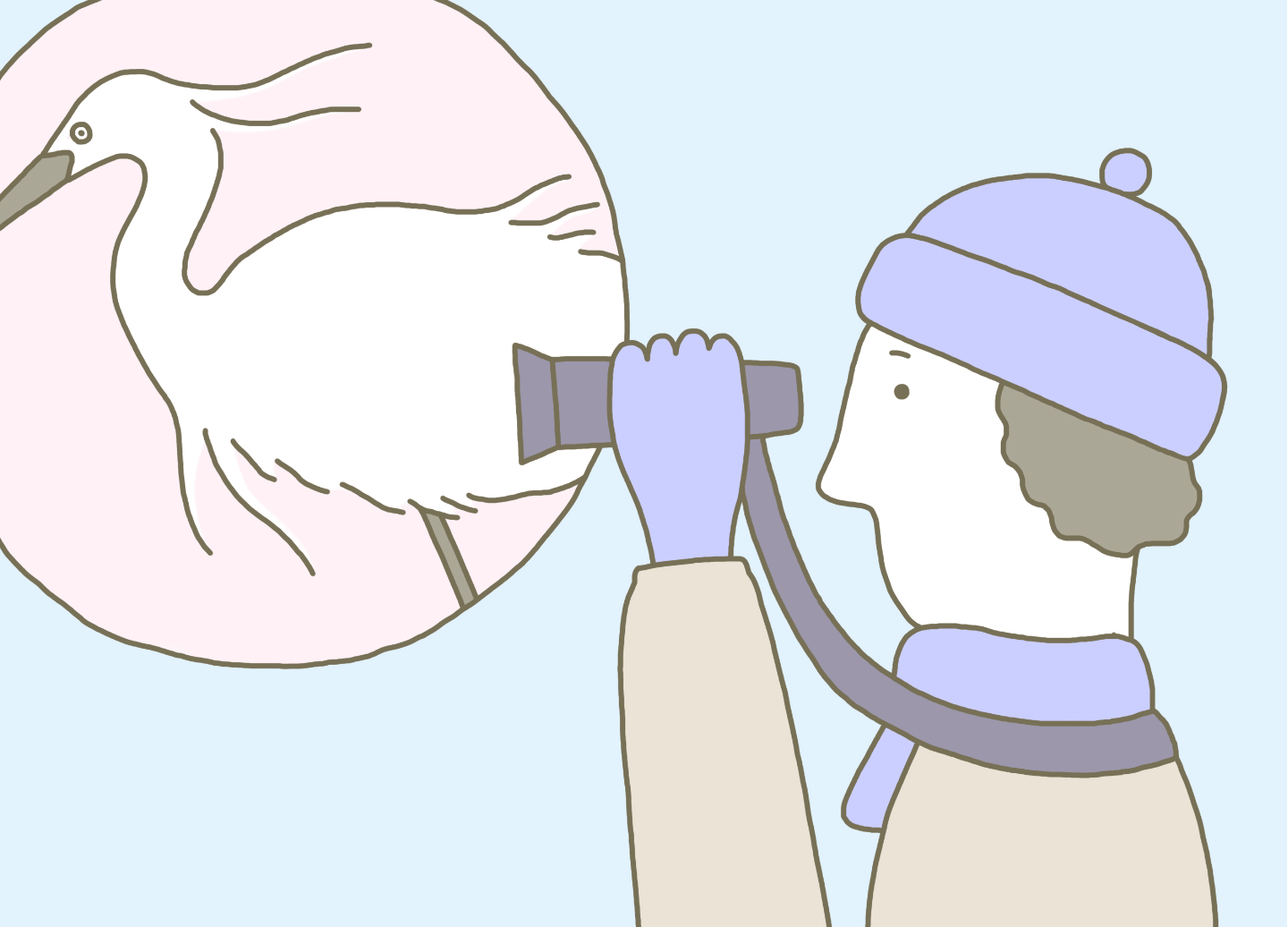

At the beginning of spring, when you still feel the cold, is the “season of love” before the start of the actual breeding season.
Birds' search for love starts from early spring.
Watch their activities, cheering on the males as they do their best to attract a female in various ways.
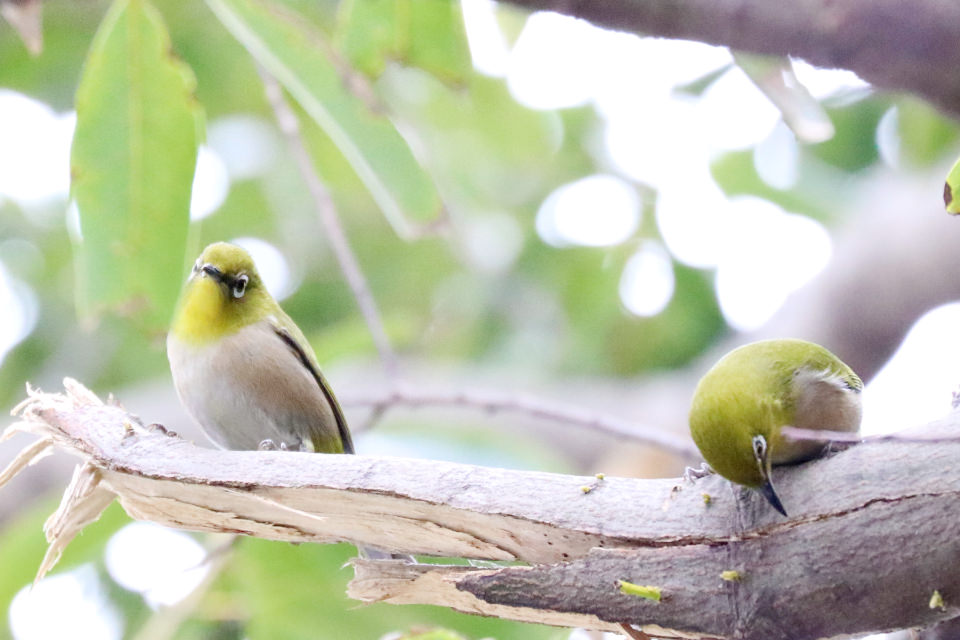

Bird watcher's report:
Text and photos by a member of the Canon Bird Branch Project
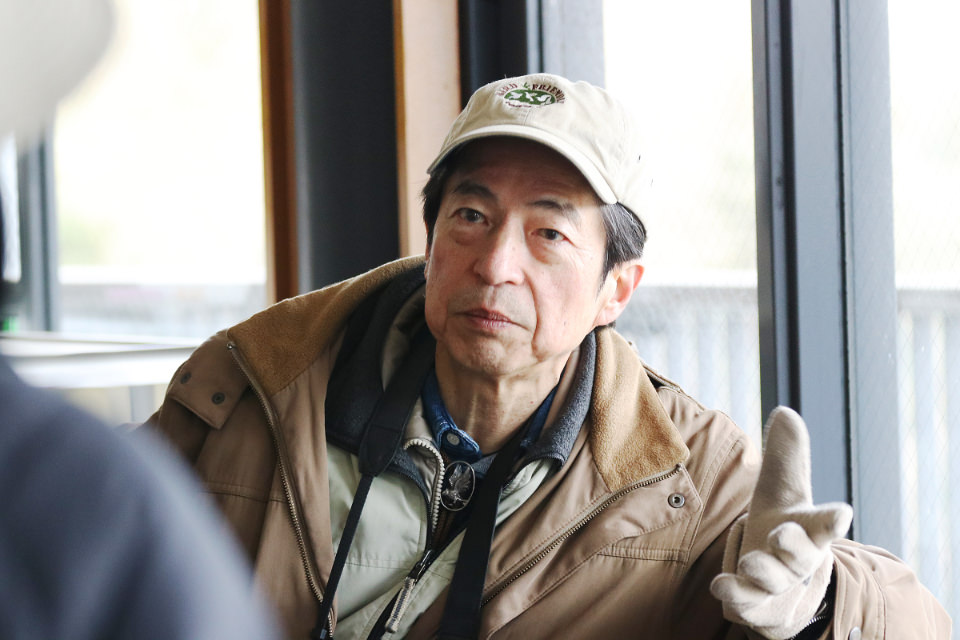
This time we visited Kasai Rinkai Park in Tokyo, located next to Kasai Seaside Park, which has a marsh designated by the Ramsar Convention in October 2018. This designation means that the area is recognized internationally as having important waterfowl habitat for water birds as well.
You can expect to find a variety of birds here due to the diversity of habitat, including freshwater ponds, groves, grasslands, and reed beds, in addition to beaches and seawater. There is also a bird watching area that is patrolled by rangers on the weekend, so it attracts many bird watchers.

Walking a short distance along the main street from JR Keiyo Line's Kasai-Rinkai Park Station, and then turning to the left, we head toward the bird watching area. According to Mr. Anzai, we will take the all-inclusive route covering the various habitats mentioned above in a full two hours.
It is mid-February, when the chill of winter is still in the air. And today is a particularly cold day.
In a loud voice, Mr. Anzai tells us that our objective today is to find the coming of spring, paying particular attention to the songs of birds, courtship behavior, and change to summer plumage, but in addition to the cold, the wind off the sea is going right through us. Shivering with cold and with some doubt, we get going.

1
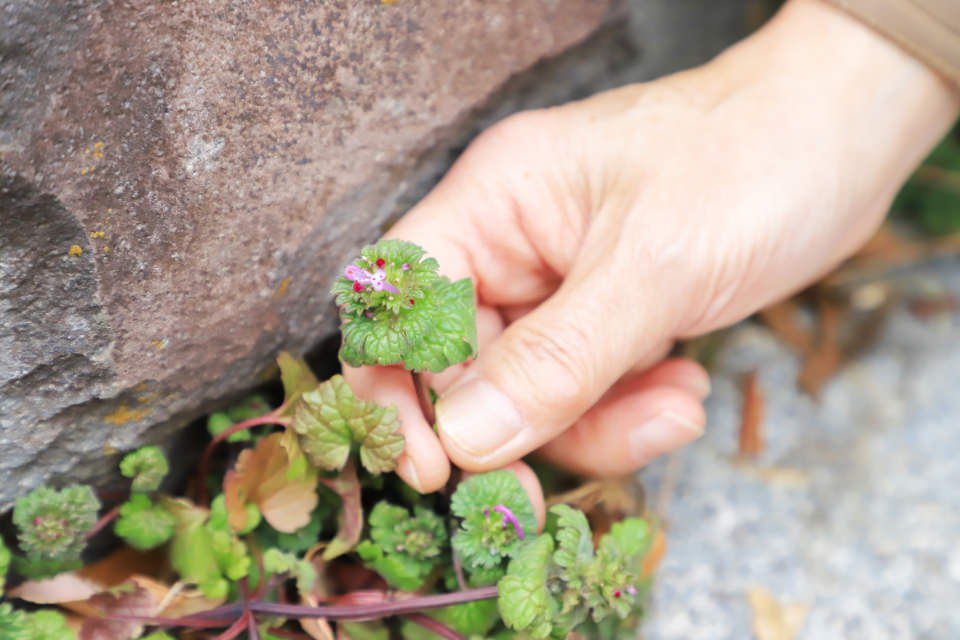
Just when I thought we were off, Mr. Anzai crouches down right away. What is he doing?
He explains: “I got a feeling of spring straight away. The pink flower of the henbit deadnettle is blooming.” Looking closely I see that the bud has just opened, and it is a pretty flower for sure.
He continues, saying, “The henbit deadnettle is the first of Japan's native plants to bloom in spring. When I find this flower, I think to myself ‘spring has come again!’ When the henbit deadnettle flowers, the ants that have spent the winter underground come above ground and start their activities.”
It looks like the henbit deadnettle also usually grows by the side of the road, but since the flowers are small, you would most often pass them by if you are not paying attention.
A few meters up the path, Mr. Anzai starts stroking the ground with his hand. What is it this time? “These are common dandelions. The leaves spread out as if they are stuck to the ground's surface, but do you see how the leaves above (central part) spread in a circular pattern? This shape, which helps it endure through the winter and take in as much sunshine as possible, is called a rosette.”
For certain, the leaves of the spring dandelion are coming up, but they were lying completely flat to the ground in winter as protection from the cold wind.
“But, you can say that it is a sign of spring because if you look closely, the leaves are rising upwards a little. In the middle of winter they would be flatter against the ground.”
This reconfirmed my understanding that various weeds also survive the winter and start their growth heading into spring.

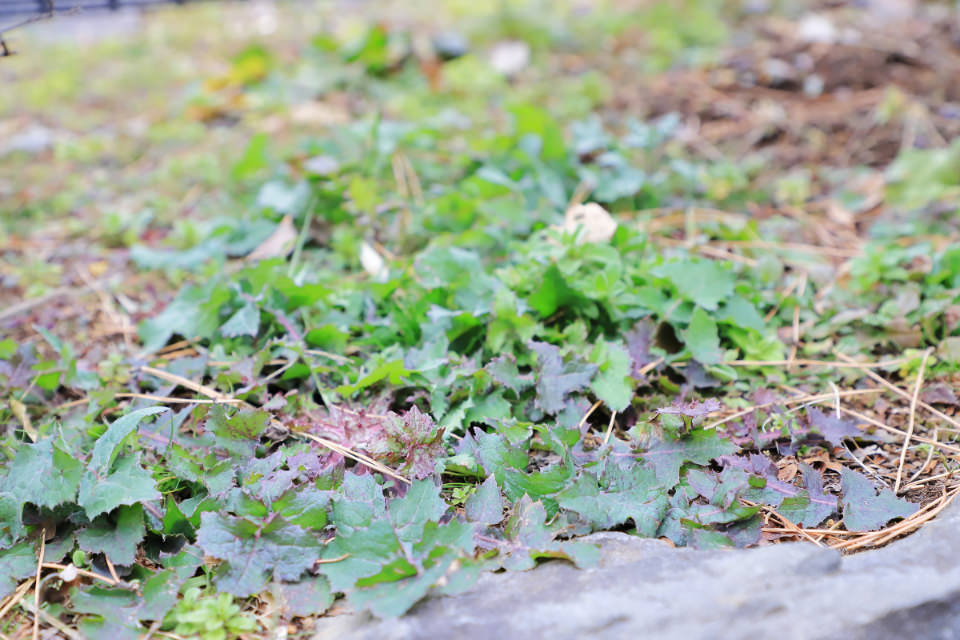
2
Walking further along, we came upon a Black-faced Bunting in the middle of the road. The people walking ahead also stopped to observe it, but it never tried to get away. It was engrossed in eating something that had fallen on the road and did not even notice us approaching it. From just a few meters away, I could easily see the markings on its yellow belly. Since I had heard that just like the Japanese Bush Warbler, it rarely shows itself out in the open, we were all excited by the special appearance of this active little bunting.
After watching it awhile, Mr. Anzai noted, “The reason it looks a little puffed up is that it might be cold. Because birds raise their feathers so their body heat does not escape… It is out in the open, but is likely so concentrated on eating that it does not even care about people.”
Certainly, this cold would be harsh for small birds. Added to that is the fact that there is not much food around for them in the middle of February. While feeling for it and hoping that it eats a lot and feels stronger, I was also happy for the opportunity to observe it from a close distance for quite a long time.
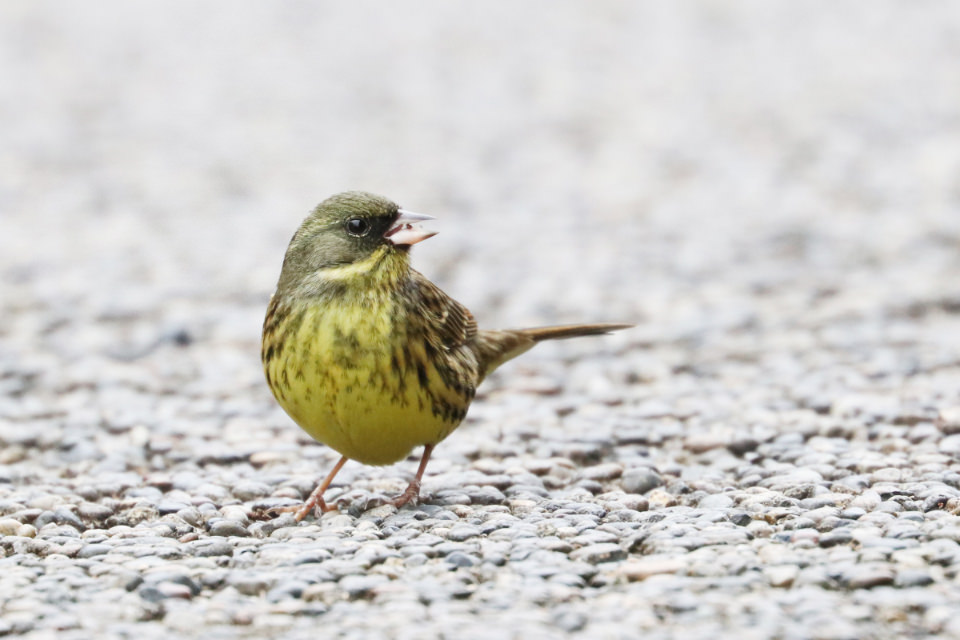
Mr. Anzai found an egg sack on the trunk of a tree and told us more about it, saying, “This egg sack of a praying mantis is full of eggs, but most will get eaten by spring. That's because overwintering insects and spiders are important sources of animal protein and nutrition in winter for small birds such as the Japanese Tit....”
“Even though more than a few insects that lay hundreds, if not thousands of eggs, why is it that nature is not overrun by insects? The eggs withstand cold and dryness, and those that manage to escape predation by birds hatch in the spring, but the larvae are an important resource for birds raising their hatchlings. Very few of those larvae reach adulthood. The lives of many insects support birds, but from insect's side of things, they have to produce enough offspring so that they are not all eaten up by birds. Really, the insects that we notice are but a few of those that have survived.”
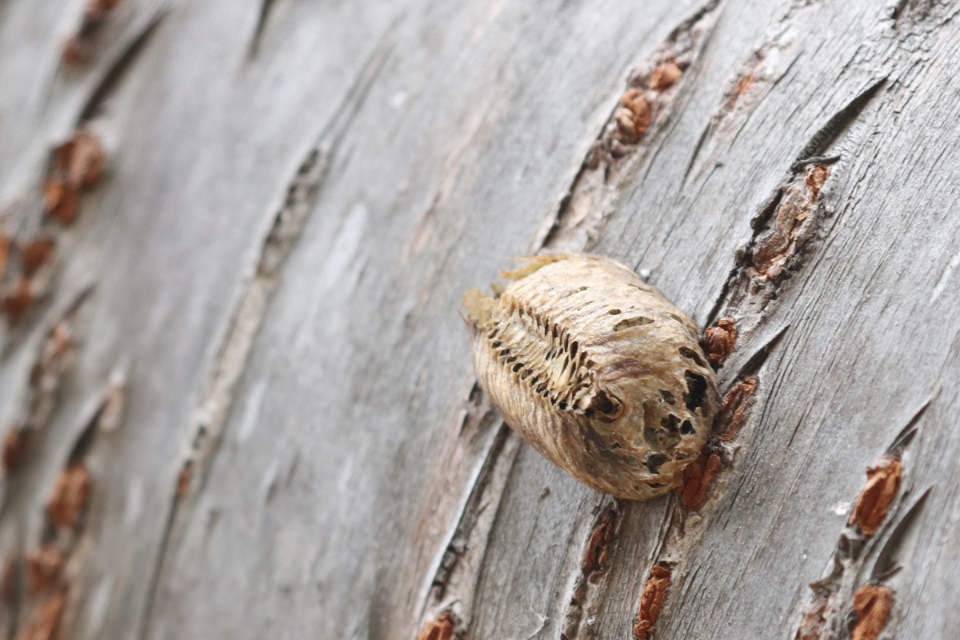
3

As we continued walking, a pond on the other side of a reed bed came into sight. The targets for observation here were duck couples.
“Even in winter, many small birds such as Naumann's Thrush migrate to their breeding grounds in Russia and elsewhere, and males begin singing to attract a female. You do not see courtship rituals or couples getting together in Japan, a wintering spot. However, ducks are different. Males seek a mate in the wintering spot, and couples are formed by the time of traveling north in spring.”
Looking at the pond nearby, there was a raft of about 10 Eastern Spot-billed Ducks. In Japan most duck species are winter birds that fly north in spring, but this species breeds in Japan.
“Males of many duck species sport beautiful plumage during the winter courtship season. An exception is the male Eastern Spot-billed Duck, who has the same dull plumage as the female throughout the year, but their search for a mate in winter is the same as other duck species.” As Mr. Anzai was explaining this, five or six Eastern Spot-billed Ducks began to dance to compete for a single female. During the courtship season, it is always the males among bird species that are the pursuers so it is easy to tell the sexes apart.
The male positions himself right in front of a female and begins his performance with various moves such as shaking his neck and raising his rump in the air. I understand that when the female chooses a male, you will see them together until they begin mating, but since I was able to see males make several attempts to challenge for a female with their courtship dance, I decided to move on.


Next we heard a flute-like call of “pili-, pili-“ coming from the back of the pond.
Mr. Anzai pipes up, “That's the voice of the male Eurasian Teal. If he's singing this actively, we'll probably get to see a courtship dance.” Sure enough, three or four males pop up around a female and start flapping their wings and raise their rumps in the air after coming up out of the water. A bird of prey, the Common Buzzard, is flying close by but they take no note and continue dancing as they pursue the female.


In the pond are also some Mallards that have already become couples. When a male and a female become a couple, they always move around as a pair, and since the male and the female duck look different, with the exception of the Eastern Spot-billed Duck, it should be easy to spot the couples.
Mr. Anzai said, “Although male ducks have colorful plumage from winter into spring, when the breeding season ends in summer they adopt the same dull plumage as females. The colorful plumage that helps them appeal to females also makes them easily visible to predators. Even though there is risk, males with their colorful summer plumage appealing to females is an ordinary sight in spring, and for duck species other than Eastern Spot-billed Ducks, the change to breeding plumage occurs from autumn into winter.”
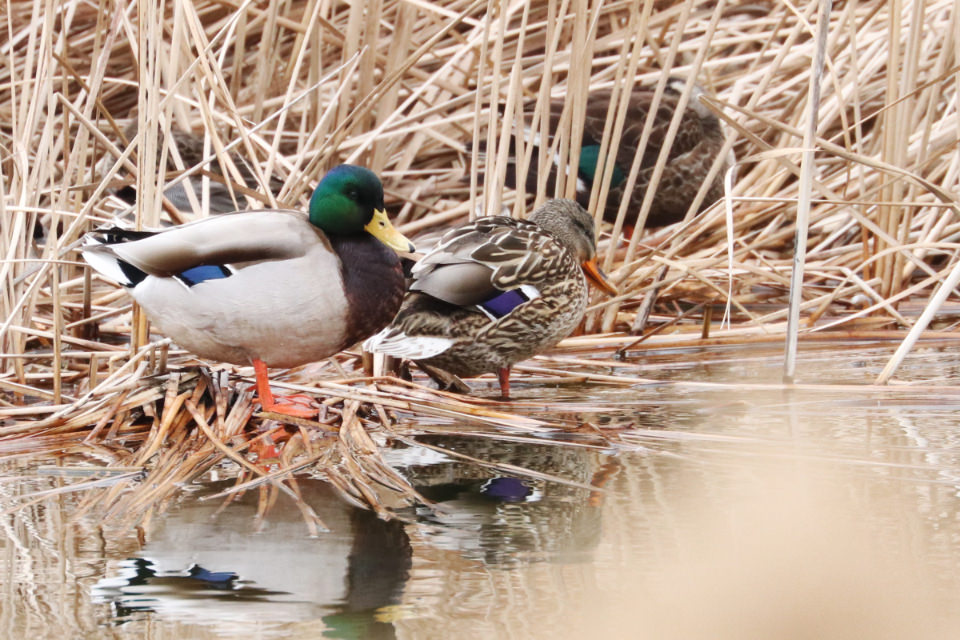

Other duck species, such as the Common Pochard, gather in large groups so it is hard to discern whether there are couples or not. It is getting closer to the time when they will migrate to northern countries, but it seems that there are still some ducks that have not found a mate, so I'm a little worried for them.
By the way, the breeding places for ducks that winter here are to the north, in Russia and elsewhere. Even though they become a couple in Japan, they can fall victim to predators during the migration or become sick, so is it possible that some will lose their partner along the way?
Mr. Anzai provides an answer, saying, “Even though there are many birds that find mates after finishing the desperate migration to their breeding place, it is not well understood why some ducks species look for mates in their wintering spot. It is thought that the advantage for ducks that couple early is an increased survival rate for the female due to having protection from the male. This is called ‘mate guard,’ the male takes on the role of protector for the female.”
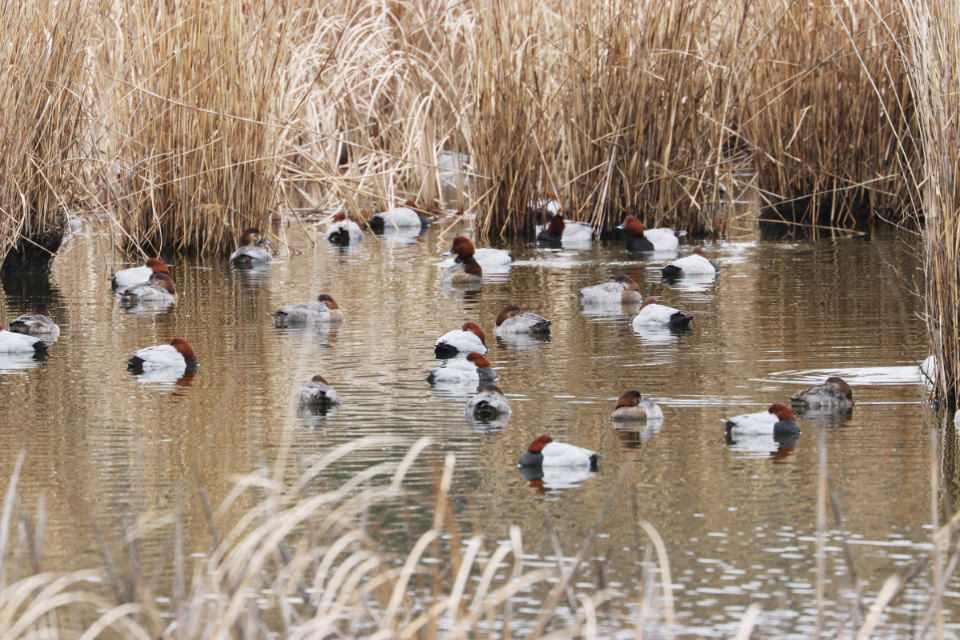

4
One of the goals on this outing was to look for birds that had changed to colorful mating plumage for the breeding season.
How about the Little Egret we found near the water?
After Mr. Anzai told us to pay attention to the head and breast of the Little Egret, we all raised our binoculars and began looking intently.
The Little Egret begins to grow long crest feathers extending to the back of its head and a lace-like spray of ornamental feathers on its breast when it is still cold outside. (See “Bird photo guide: Little Egret”)
We could not confirm the crest feathers on this Little Egret, but we could see a few ornamental feathers on its breast and back.
Mr. Anzai invited us to look closely, saying, “As we approach the actual start of spring, many birds will become more beautiful each day, so please enjoy watching the change.” I thought that this spring I should definitely look carefully at birds and other living things that I had missed before because of not knowing about them.
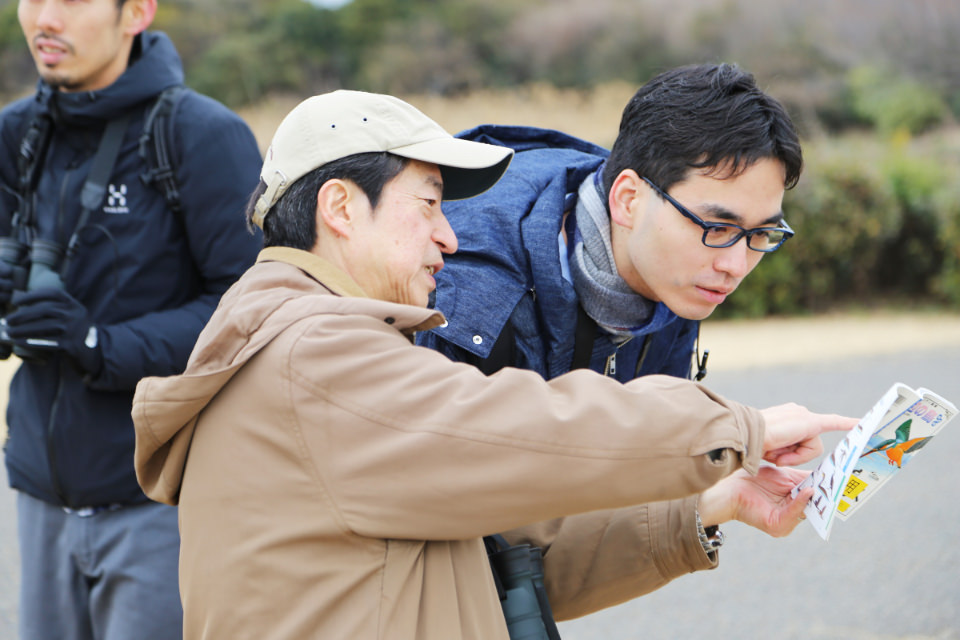
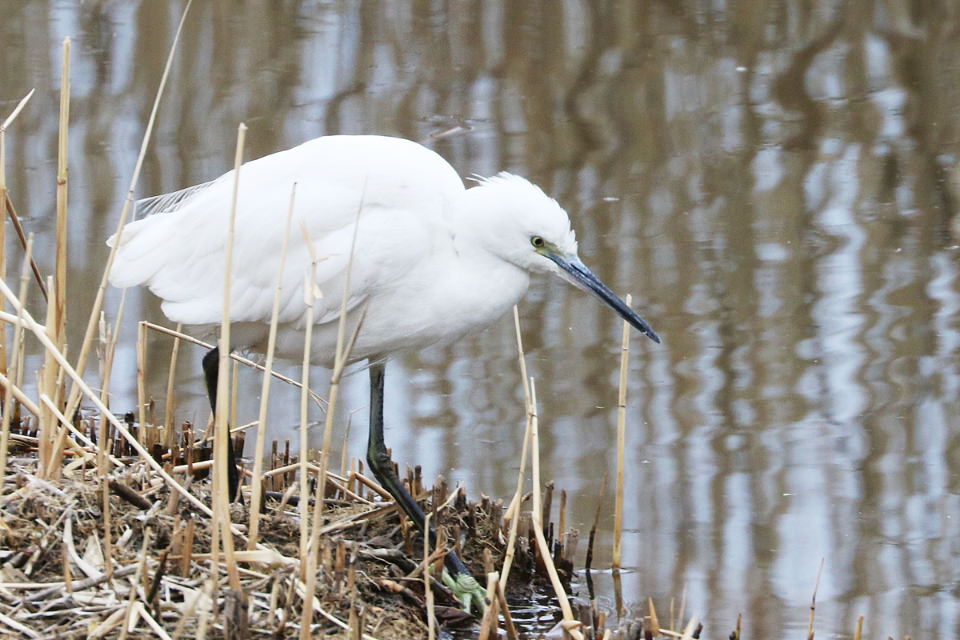
Coming out to the seashore, we saw some ducks, including Greater Scaups and Tufted Ducks, and Great Crested Grebes swimming.
“I wanted everyone to see the Great Crested Grebes as they start to change to their beautiful plumage, but it appears that for the most part they still have their dull winter plumage. And, also please look at the Greater Scaups.”
One of the reasons why Kasai Seaside Park has been distinguished as a Ramsar Convention Wetland is that many Great Crested Grebes and Greater Scaups spend the winter in this marine area.
In the air above the sea were flying some of the gull species, including the Herring Gull and the Black-headed Gull appointed as a bird of Tokyo Metropolitan.
I understand that before long the Herring Gull will change to its summer plumage, being completely white on its head, while the Black-headed Gull will change to its summer plumage when it is about to travel north from April into May. (See photo guide for(See “Bird photo guide: Black-headed Gull”)
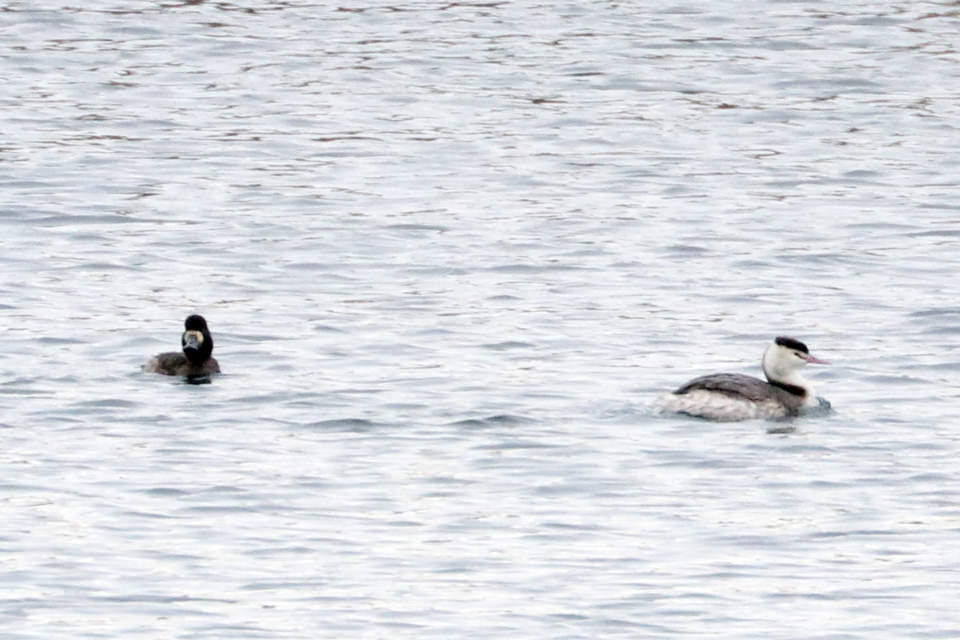
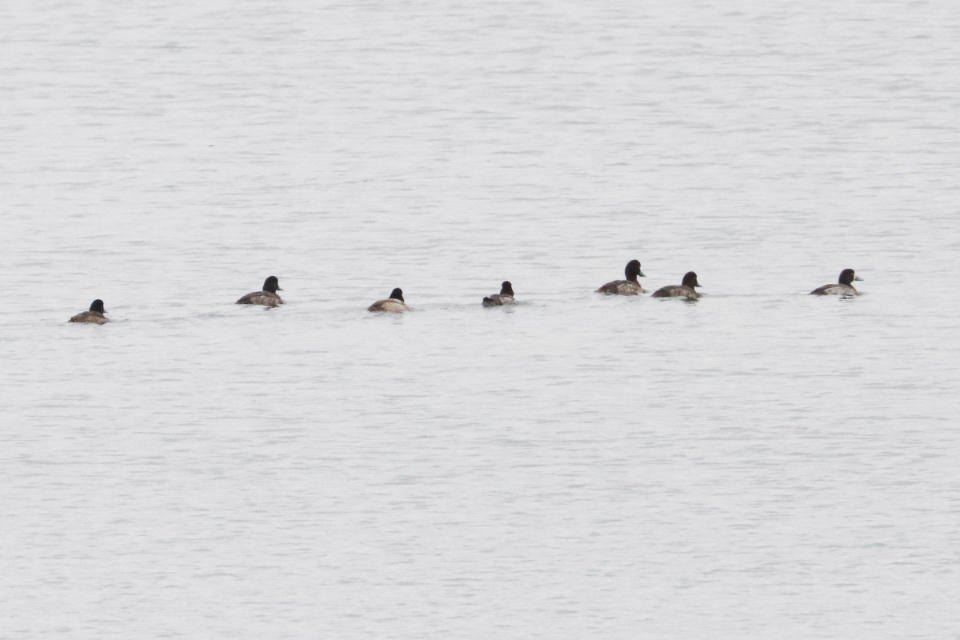
5
“Earlier we saw a happily married Mallard couple, but let's see if we can't find some couples among the small birds! Eurasian Tree Sparrows begin to sing and dance in February, and since flocks of White-cheeked Starlings have started to break up, we may be able to see some early couples,” noted Mr. Anzai. For sure, looking for small birds that are familiar will be enjoyable for beginner bird watchers.
Just as he said that, we found a flock of White-cheeked Starlings on the move.
Mr. Anzai gave us a pointer, saying, “If two White-cheeked Starlings are next to each other, you can tell the male from the female since the male is darker in color.”
Looking through binoculars at members of the White-cheeked Starling flock one by one, there certainly seems to be a difference in color, but I'm not sure I could correctly tell males from females when observing them on my own.
“Since each couple becomes occupied with raising its young when spring arrives, it is easier to tell them apart. There are some large birds that need more than two years to reach adulthood, but since it normally takes one year to reach adulthood, if birds born in the previous year survive until the spring they will breed. In other words, in due course it becomes the natural season for couples.”
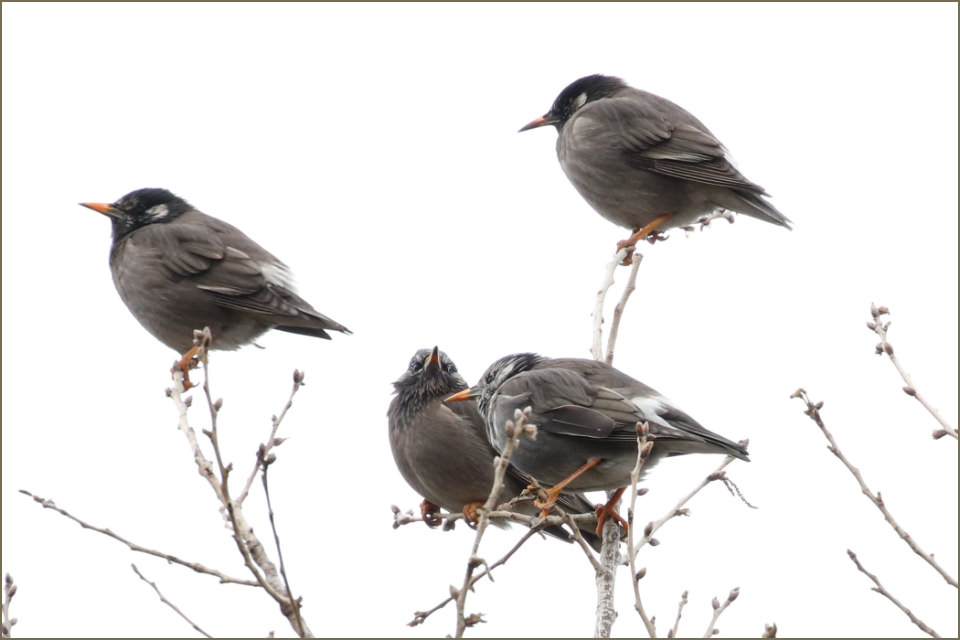
“It might be the fault of the exceptional coldness today, but the Japanese Tits are not singing. We didn't observe allopreening of the Japanese White-eye, or courtship feedings of the Bull-headed Shrike or crows, so we aren't getting to see much, are we?” exclaims Mr. Anzai.
It really is too bad we were not able to observe nature as we hoped. Since I see Japanese Tits, Japanese White-eyes and crows on my way to work, I decided I should pay them more attention.

6
Our final destination of the day was the sanctuary's Bird Watching Centre.
Straight away, we went up to the second floor and started watching birds. The building is surrounded on all sides by bodies of water or reed beds and woods. The view is excellent and they also have a telescope set up for visitors to use.
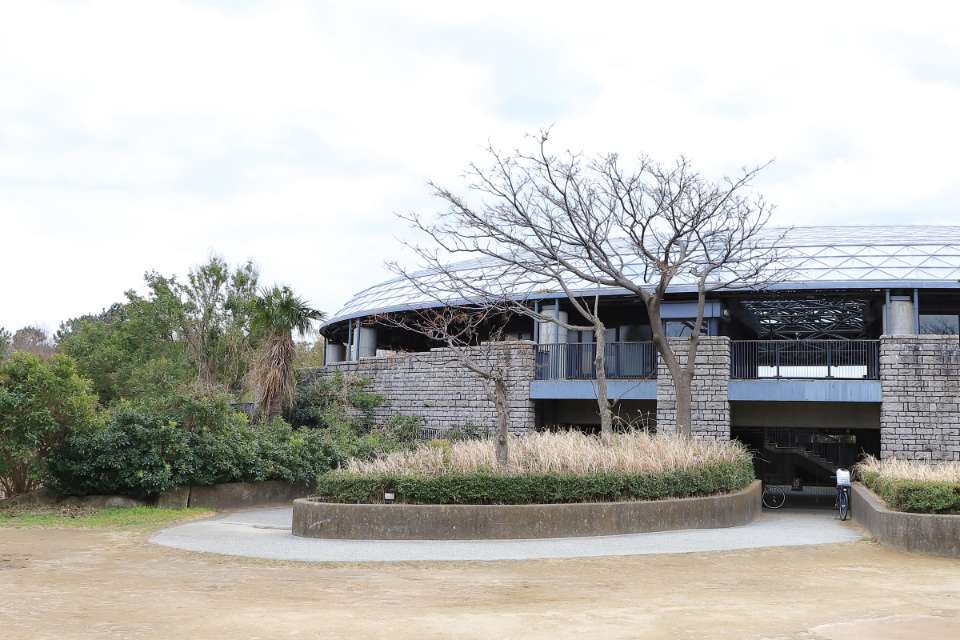
Right away we found two small birds moving about. The White Wagtails are here! But how do you know if they are a couple or just two birds wandering around?
Mr. Anzai replies, “Two birds together would be a couple if it was actually spring, but since it is still February, let's first figure out if they are male and female. The male White Wagtail changes from gray to black on its back for its summer plumage. The White Wagtail in the foreground has black feathers mixed in so we know it is a male that is beginning to change to summer plumage. But since he is still in the midst of changing to summer plumage, the female would not have chosen him, so this male and this female are not yet a couple. ”
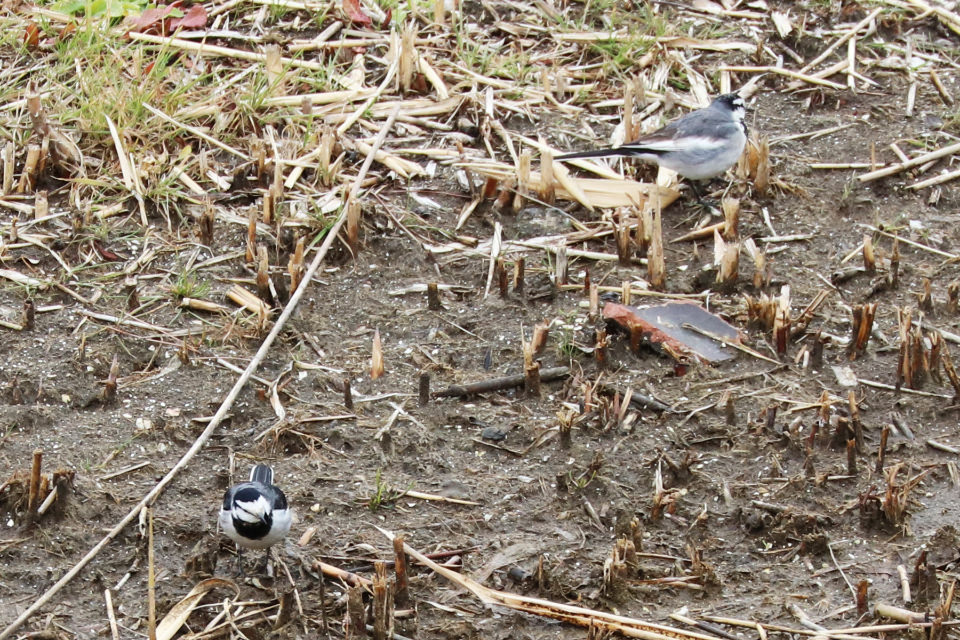
Leaving the Bird Watching Centre, we hear a sound like “pachin, pachin” coming from the reed beds. It is a Common Reed Bunting, the representative resident of reed beds in winter. The sound is that of the bird pecking a reed stalk in order to get at the scale insects inside to eat them. Apparently the head of the male becomes black with its summer plumage, but from what we could see this time it still had its winter plumage.
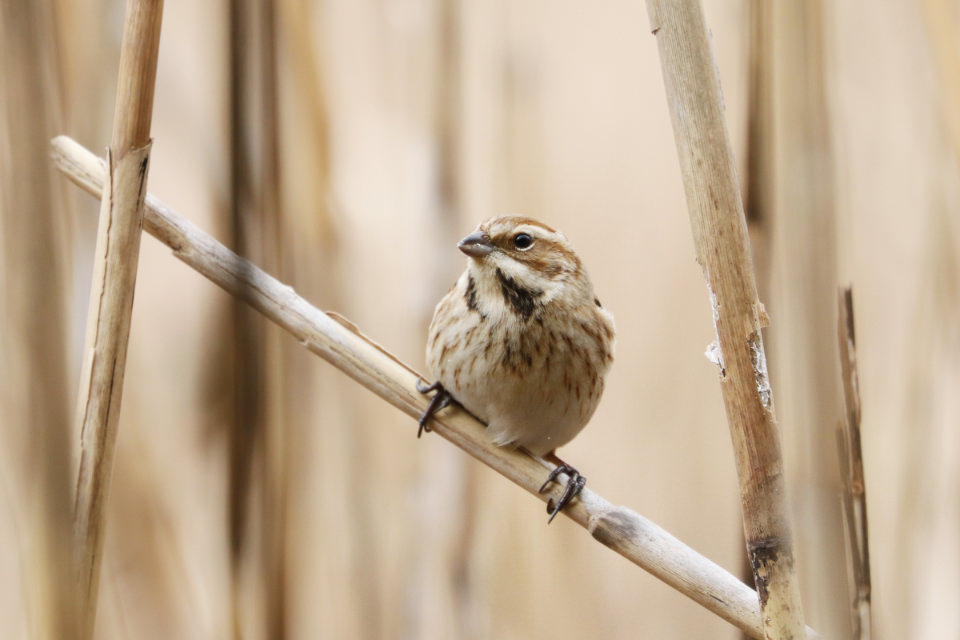

We started our bird watching outing at ten this morning and finished just after noon.
Mr. Anzai commented, saying, “Many people feel ‘spring’ by the temperature, but for birds and other creatures in the wild, it is not only heat or cold, but also hours of sunlight that have a big influence. As the days become longer they feel spring and start preparing to produce offspring.”
To be sure, to our senses, February is still very much winter, and we feel that the arrival of spring is still far off. It was a cold day today, but hearing about the changes that plants and birds make as spring approaches, I was able to give more than a passing thought to the season to come.
I hope that you will also give attention to the familiar birds around you and feel the cycle of the seasons.
Greater Scaup, Common Pochard, Tufted Duck, Teal, Northern Shoveler, Eastern Spot-billed Duck, Gadwall, Mallard, Great Cormorant, Little Grebe, Grey Heron, Little Egret, Great Egret, Coot, Black-headed Gull, Herring Gull, Common Sandpiper, Sparrowhawk, Common Buzzard, Pale Thrush, Daurian Redstart, Black-faced Bunting, Japanese White-eye, Brown-eared Bulbul, White-cheeked Starling, Japanese Tit, Eurasian Tree Sparrow, Common Reed Bunting, White Wagtail, Azure-winged Magpie, Japanese Bush Warbler, Oriental Turtle Dove